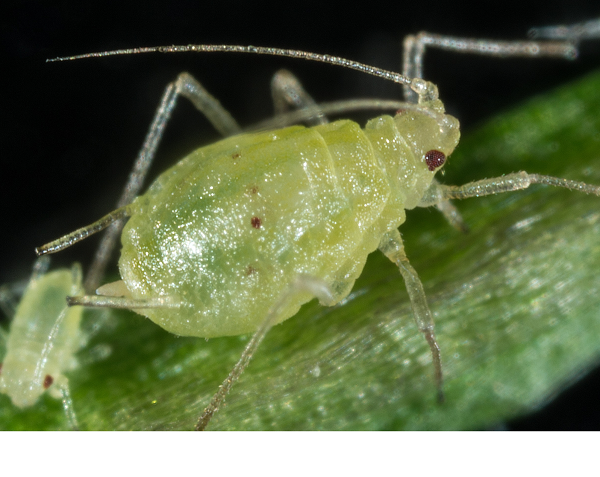Aphids have had a bonanza year, putting the sugar beet crop under intense pressure from virus yellows. CPM gets the breeder’s view on addressing the virus yellows challenge having left the EU.
A single gene solution isn’t desirable because it’s unlikely to be durable.
By Lucy de la Pasture
Very few sugar beet crops will have escaped a touch of virus yellows this season. According to BBRO, aphid numbers reached unprecedented numbers this spring, with as many as 50 winged and 200 wingless aphids/plant recorded on plants at their peak.
“Aphids began migrating in the third week of March and reached high levels in April and May, when some crops were still at the cotyledon or first leaf stage. Other crops had staggered emergence, so plants were at multiple growth stages and some plants were susceptible for a long period of time,” explains Prof Mark Stevens speaking at the BBRO’s virtual BeetField20 Live last month.

Aphid numbers soared to unprecedented numbers this spring and insecticide programmes haven’t been wholly effective at preventing virus infection.
The forecast for virus yellows infection for the national crop this season was for 70-90% without any aphid control measures. Legally this season it has been possible to apply up to five applications of insecticides, though there have been supply problems and most growers have applied three sprays, he adds.
“Even though the numbers of aphids actually infected with virus is low, the very high numbers present this season have meant there’s been a very high virus pressure. The extent of the yield loss will depend on when the virus came into the crop and which type of yellowing virus it is,” adds Mark.
While the industry crosses its fingers that winter will do its worst and reduce the virus potential for next season, there’s an uneasy awareness that virus levels in the current crop aren’t as bad as they might have been. Fortuitously the infection rate in aphids is still low in the second season of growing beet without neonicotinoid seed treatments, but another mild winter and it could be a different story.
“Farming is a constant battle against weeds, pests and diseases. As breeders we’re constantly trying to anticipate needs and breed solutions but with fewer chemicals, more pest threats and diverging approaches in many countries, it’s getting increasingly challenging,” suggests SESVanderHave UK managing director, Ian Munnery.
“The impact of virus yellows on sugar beet and fodder beet is a case in point and we presented this to the All-Party Parliamentary Group on Science and Technology in May via Zoom.”
Virus yellows infections were widely predicted following the neonicotinoid seed treatment ban in 2018, says Ian. “Following a mild winter and, despite emergency approvals and timely application of three foliar insecticides, the volume of virus-carrying aphids swamped many crops. For 2020 harvest it’s hoped yield losses will be checked at 5-10% on infected fields, but with the probability that even more insecticides may be needed in 2021 to control the vector, we need to reflect on the sustainability of this approach.”
As plant breeders, SESVanderHave identified the threat from the loss of neonicotinoid seed treatments over 10 years ago and have been working on a number of research projects to accelerate the introduction of virus yellow tolerant genetics into varieties using conventional breeding, he explains.
Over the past four years, an Innovate UK-funded study involving the BBRO, ADAS and sugar beet breeders Maribo-Hilleshög and SESVanderHave, has identified a number of promising sources of genetic resistance to virus yellows.
“There’s currently no single, major resistance gene identified to provide a quick fix. And with the diversity and high fecundity of aphids, a single-gene solution isn’t desirable because it’s unlikely to be durable. Similarly, we’re dealing with a cocktail of three or more ‘yellowing’ viruses in the UK and multiple vectors, so relying on tolerance to a single virus may just allow another one of the ‘virus cocktail’ to dominate.
“Instead we need to look more holistically and integrate multiple traits alongside the tolerance to virus yellows which we’ve already identified from our research projects.”
With finite resources to spend on conventional breeding for a range of resurgent and new threats, there’s a requirement for clarity on UK regulatory divergence from the EU, stresses Ian. “It’s clear that even before Brexit, many EU states voted to ban neonicotinoid seed treatments, yet continued to issue derogations, providing a competitive advantage to their growers. Equally in the UK, if serial derogations are going to be the new normal, then is there a need to breed for virus yellow tolerance?”
Ian believes that the simple answer is yes. “To have durability we need to disrupt resistance by not focusing on a single product – be that chemistry or genetic – and as demonstrated this year, even three foliar insecticides don’t provide a wholly effective strategy.”
Breeding to contain virus yellows is the biggest challenge to date, he adds. “The urgency now is to transfer these sources of genetic resistance we’ve identified into commercial solutions. We have the opportunity to accelerate delivery of new traits, widen our breeding targets and reduce costs and chemistry use through the use of New Plant Breeding Techniques (NPBTs).
“Techniques such as gene editing could accelerate the introgression of beneficial traits into elite germplasm, potentially producing market-ready varieties within 2-3 years rather than 10-12 years. It remains uncertain when, or if, the UK government will provide some clarity on their vision for regulatory divergence,” comments Ian.
“What is clear from looking at the fields pockmarked with virus yellows is that our ability to protect our crops is at increasing risk. For sugar beet, it’s particularly poignant given the yield improvements we’ve delivered in the UK. If sugar beet production become unviable then the alternative is to see supermarket shelves filled with imports from countries which have been able to harness the full armoury to produce their sugar beet crops more efficiently.”




